Hey guys, Nikki with posh dog knee braces here. So, first of all I can’t stress enough the need to do some form of physical therapy. We send every patient home with a 12 week recovery calendar and exercises, however, we need you to keep those up for the full 9 months. Whether you find a holistic or physical therapy clinic to help you with water treadmill or PT, you need to keep you dog active in some way.
Lack of activity will cause a joint to “lock up” after the scar tissue has formed, meaning there is not going to be the same amount of range of motion there. There also can be loss of muscle. The brace alone is not enough to build muscle, you will need to keep walking your dog, and doing some form of exercise program. This is needed whether you do surgery, Conservative management, or bracing. Doing nothing will result in loss of muscle, loss of range of motion, and most likely arthritis and pain down the road.
We have a lovely list of holistic veterinarians and rehab clinics around the US and in Canada, so reach out if you are struggling to find a clinic. The clinics on our list are partners with posh, and know how to treat our patients, as well as measure and fit the brace if needed. We do have some things we can have you do from home as well, if PT is just not in the budget. I am happy with walks, simple exercises, and passive range of motion.
What is PROM? This is you gently bending and flexing the knee, as well as the hip. I have videos we send to you on how to do this stretching, but this is key to keep flexibility in the joint, and not end up with lack of movement there.
Please let us know if you have any questions, poshdogkneebrace.com or visit our Facebook Page. Thanks!
Hey guys, this is Nikki Lead Veterinary Technician with Posh Dog Knee Braces. Today, let’s talk about Cranial Cruciate Ligament Repair (CCL/ACL) tears in a dog, and what your options are. First of all, if your dog is limping on the hind leg, be sure to get a diagnosis from your veterinarian before making any decisions. Once that takes place, be firm with your Veterinarian if needed and ask for the exact diagnosis. If they feel that your dog has a Cranial Cruciate Ligament tear, or CCL tear, then you do have some decisions to make moving forward. Let’s go into the options, and the pros and cons, as well as long term expectations.
First off, depending on your veterinarian, they may refer you to a specialist to verify the diagnosis. This is completely up to you, but do know that if you go to a specialist, they are typically surgeons, and will not be happy without scheduling your dog for surgery. Please know that you can say no. I can’t stress enough how important it is for you to take a breath, and go over all options before signing that dotted line.
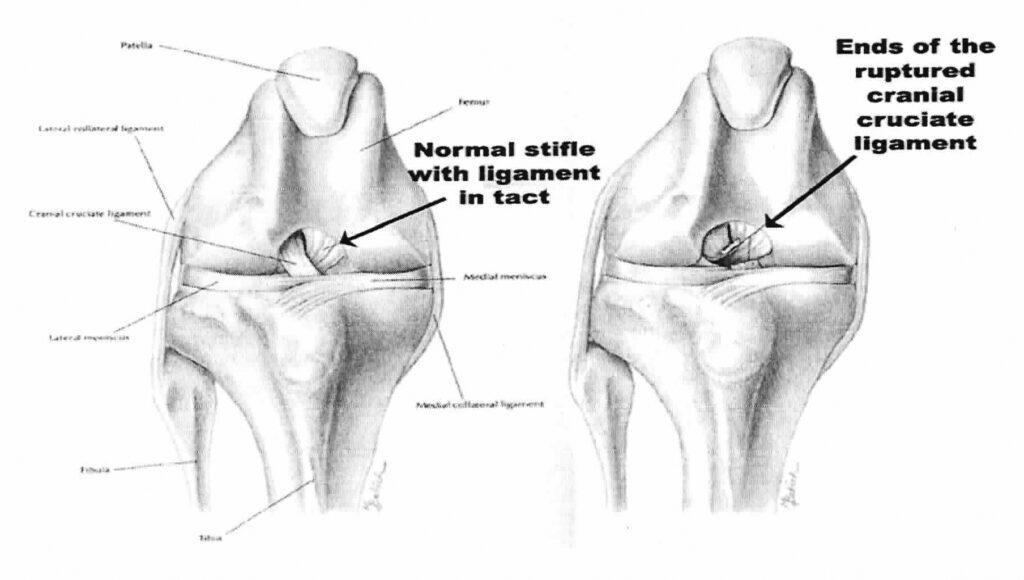
Choosing to do just conservative management, with no support or surgery. This seems to be gaining momentum and popularity, because obviously options can cost money. There are supportive things to do, such as keeping your dog in a kennel, leash walks outside, supplements, acupuncture, laser, prp, ect. While this option is better for the budget, it is not for the busy owner, or owners with small children and other pets. While it sounds great, reality is that there is a great chance your pup will continue to re-injure their knee. At some point, the door will open, and your dog will want to run.
Someone will forget, your dog looks like he is dong better at 3 months, and in he comes with the leg hiked all the way up to the groin. Sound familiar? This can be a tough cycle, and the bones in the knee are still able to move, causing pressure on the meniscus as well increasing your dog’s chance of arthritis down the road. So, can a knee heal with conservative management alone? Possibly, but there could be long term issues if you do not do passive range of motion, PT, and exercising along with CM alone.
This is by far my favorite option, from years of experience working with orthopedics. Using an orthotic Brace in conjunction with PROM and PT, as well as supplements and support. Now I am not talking about the cheap over the counter neoprene braces that have a spiderweb of straps connecting to the harness or back, those are no better than just letting the knee recover alone.
I am talking about a custom made premium orthotic brace, such as the Posh Dog Knee Brace. Posh Brace fully stabilizes the knee, allowing for range of motion and squatting, while also acting as a shock absorber for the meniscus. This is going to help give a smoother recovery, and allow that scar tissue to form without a lot of re-injuries. Thus, this is one of the safer options, and definitely still less than surgery.
Tightrope, lateral suture, or extracapsular repair. This is the cheapest of the surgical options, and should only be used on patients under 30-40lbs, as the suture has double the chance of failing in larger breed patients. This method usually is in the $2k-$3k ballpark range now, and is literally using fishing line/or suture to wrap around the knee joint to keep things in place. There are several ways this can and usually does fail. The crimps can come off, the suture can break, the suture can slip, ect.
These patients are immobile for months, and do get a lot of atrophy in the joint. This seems to be sore to recover from, and without a brace post op, your dog is going to need to be kenneled for weeks to months, to allow for scar tissue to properly form. This technique is similar to if you braced, however, without the full stabilization and support, and double the cost.
TPLO or TTA surgery. Both of these will be suggested by your vet or surgeon, usually first. They both entail cutting of the tibia bone, and re-alignment using a plate and screws. This is permanent, and there is no going back if something doesn’t go the way it was meant to. I always save this for my last option, as it is extremely invasive, expensive, and does not give a guarantee of working. Too many patients have had lifelong lameness due to choosing this option, and are not able to recover fully.
There are many weeks needed for kenneling, so the leg will atrophy. This also causes overcompensating on the good knee, which again increases the chances of another CCL tear in that leg. If surgery does go well, and you are able to do a full Physical Therapy Program post op with a professional, your dog may have a good outcome, but this is not without risk.
Please email me at poshintake1@gmail.com if you would like to ask more questions about Cranial Cruciate Ligament Repair, CCL/ACL tears in dogs, and what the best options are for your pup. You can also contact via our forms or visit our Facebook page.
Dog Knee Recovery Without Surgery
By Rosemary Levesque, Licensed Spiritual Healer
Second Nature Healing®https://secondnaturehealing.com
Rosemary@secondnaturehealing.com or call directly 503-747-3307
The following article is written in gratitude to Posh Dog Knee Brace for their support during Gracie’s recovery from a torn CCL. Gracie wore the brace and healed well without surgery. In honor of Gracie who had a long healthy life, I’m offering:
The cranial cruciate ligament (CCL) in dogs is a band of connective tissue that connects the upper leg bone (thigh) to the two lower leg bones (tibia and fibula) at the knee joint – called the stifle in dogs. The CCL helps stabilize the stifle, and is highly vulnerable to tears which destabilize the joint. Damage to the knee joint is the leading cause of rear-leg lameness and the major cause of degenerative joint disease in dogs. (1)
If you can’t wait to get started with healing and recovery, please begin here.
My number ONE product source for healing and recovery is https://avinihealth.com/rosemary.
These products are designed with humans in mind, but with my years of experience working with animals, I know how critical it is to use these products, safely and easily, across the board, with all species. Call me for a consultation on how to help your dog heal faster, without surgery, using the Posh Dog Knee brace and my products.

There are many situations that could result in a CCL tear:
Contributing factors like obesity, genetics, and general health may also have a role in causing a torn CCL. Since animals are excellent at hiding their injuries and illnesses, you’ll want to be especially observant if you suspect a tear. In addition to limping or lameness, watch for muscle atrophy in the thigh or imbalance in the spine.
When Gracie jumped into the car as usual one beautiful spring day after a pleasant walk in the park, she yelped in pain. Yet after her initial jolt, she seemed fine. She ate and walked normally for several weeks until we had our next vet visit, a yearly wellness check-up. Suddenly she picked up her hind leg, revealing her lameness. It surprised me that she’d wait until we were in his office to say something about her problem. She hadn’t shown me any sign of lameness since the incident a few weeks prior.
A veterinary examination for stifle injury usually includes manipulation of the joint and is called a “drawer test”. Physical manipulation of the joint forces the ligaments to stretch and tear more. Unfortunately, it was an issue and Gracie became obviously lame after that. That’s why I add this test to the list of causes. Even if a small tear already exists, it can worsen after such manipulation. If you suspect a torn CCL, do NOT allow your vet to perform the drawer test.
Our vet suggested that we see a specialist for CCL surgery. He also offered cold laser treatments at his clinic to help speed healing and recovery. I felt hopeful about Gracie’s healing and recovery with the healing methods I already know and use. So, in addition to frequent cold laser treatments, my plan included Reiki, essential oils, and acupuncture. I opted to not have invasive, expensive surgery.
The most common response to a torn CCL is to perform a surgery called Tibial Plateau Leveling Osteotomy (TPLO). In this surgery, the tibia, a lower leg bone, is cut (leveled) and rotated to change the direction of movement. A plate is added to secure the new location of the joint. Following weeks of immobility and pain management with medications the problem may be resolved. The cost of surgery and x-rays may range from $2500 to upwards of $6000.
However, cost isn’t the only issue to consider. Weeks of restrained immobility are not only depressing for your active animal, but difficult to control and have other effects such as weight gain, muscle atrophy, and risk of infection as well as the risks associated with the surgery itself. Pain medications can often have harmful side-effects. More importantly, studies now show a definite link between TPLO surgery and osteosarcoma (bone cancer) at the site of surgery.
“. . . dogs with a history of TPLO were 40 times as likely to develop proximal tibial osteosarcoma as were dogs with no history of TPLO. In addition, each 1-kg (2.2-lb) increase in body weight was associated with an 11% increase in the odds of proximal tibial osteosarcoma.” (2)
What’s really best for your dog? Is there another way?
Gracie did well with the holistic methods I used to support her healing. Most importantly, we were still able to walk her short distances while she gradually improved. We purchased a set of stairs for the car so she wouldn’t jump into the car anymore to risk further injury. We added specific supplements to support joint healing and repair.
All of it worked pretty well until one cold winter day when Gracie slipped on the ice. She reinjured her CCL and was in obvious pain. Back to the start once again, I panicked and scheduled an appointment with a surgeon for that week. Fortunately, my intuition told me to keep looking. That’s when I found the REAL ANSWER that saved Gracie’s knee and allowed her to heal – finally – without surgery.
I began searching for a knee brace for Gracie and discovered that they fall into several categories:
Of course, the custom fit seemed like the better way to go, and quality, durability, and customer service and support were also important. That’s when I finally found Posh Dog Knee Brace. (3) They provide a way to make a custom fit brace with highly durable materials that are waterproof (and beach-proof) and long-lasting with a superior guarantee. Their fast service provided us with a custom-fit brace for Gracie in just days.
Immediately on the first try-on, Gracie was able to take her first steps. We started using the brace for short walks until she regained her strength and balance. That’s when I noticed how much she had been compensating for her injury. She was finally able to walk straight without limping, and without any curve or adjustment in her spine. The thigh muscles which had atrophied began to get strong once again. We continued with natural healing techniques and tools which were much more effective now that Gracie had the support of her brace to stabilize the stifle.
There may be little difference in perceived success when comparing TPLO surgery to using an ordinary or inferior knee brace (one that doesn’t fit properly or doesn’t fully support the stifle joint). I believe the real differences come in the form of ease and comfort while healing as well as from the quality of the brace. Many of the sites I investigated, including articles from the American Veterinary Association, Veterinary Medicine websites, and holistic journals gave a more comprehensive picture. Surgeons at the School of Veterinary Medicine at the University of Pennsylvania don’t use TPLO surgery.
Dr. Amy Kapatkin, a board-certified orthopedic surgeon says, “Why break a bone to fix a ligament” (4)
It’s critical to support healing from every angle while the stifle joint is stabilized.
[1] https://www.petmd.com/dog/conditions/musculoskeletal/c_dg_cranial_cruciate_ligament
[2] Association of tibial plateau leveling osteotomy with proximal tibial osteosarcoma in dogs
Journal of the American Veterinary Medical Association
September 15, 2018, Vol. 253, No. 6, Pages 752-756
Laura E. SelmicBVetMed, MPH; Stewart D. Ryan BVSc, MS; Audrey Ruple DVM, PhD; William E. Pass DVM; Stephen J. Withrow DVM
Flint Animal Cancer Center, Department of Clinical Sciences, College of Veterinary Medicine and Biomedical Sciences, Colorado State University, Fort Collins, CO 80523. (Selmic, Ryan, Pass, Withrow); Department of Comparative Pathobiology, College of Veterinary Medicine, Purdue University, West Lafayette, IN 47907. (Ruple)
[3] https://www.secondnaturehealing.com/docs/Posh%20Flyer%20Gracie%20-%20SecondNatureHealing.pdf
[4] https://www.whole-dog-journal.com/issues/13_2/features/Dog-Surgery-Alternatives_16198-1.html
Dog knee injuries may have some correlation with poor conformation, but a dog’s weight, health, and activities all have a significant impact.
A patellar luxation or a cruciate ligament damage is the most common knee injury in dogs. An abnormal patellar conformation, also known as a patellar luxation, or dislocation, is typically caused by congenital abnormalities. Despite the possibility of a conformational component, trauma is typically the cause of cruciate ligament injuries. Both are painful and need medical attention from a veterinarian.
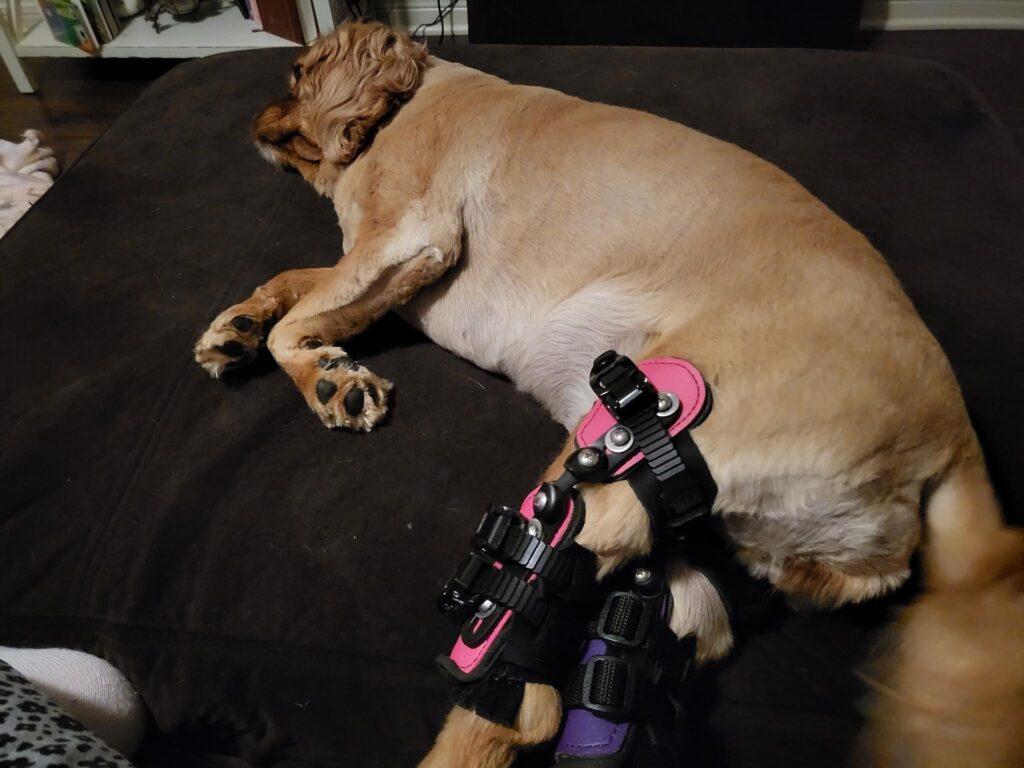
Your dog’s patella is its kneecap. The femoral trochlear groove, which is naturally present at the femur’s end, is where the patella ordinarily slides up and down in the middle of the knee. Unfortunately, the dog’s knee might develop genetic flaws that cause the kneecap to slide to one side or the other. A lateral luxation occurs when it slips to the outside. It is a medial luxation if it slides inward.
The majority of medial luxations affect tiny breeds like Boston Terriers, Chihuahuas, Miniature Poodles, and Pomeranians, Akitas, Great Pyrenees, Flat-Coated Retrievers, Chinese Shar Peis, and other large dogs frequently exhibit lateral luxations.
Only 7% of puppies have patellar issues, and the majority of them exhibit signs of luxation in both back legs.
You might notice your dog “skipping” occasionally when he moves, holding up a leg, or pausing and extending out his back limb before moving again if his kneecap is misaligned. Puppies with severe luxations may modify their stance, giving them a knock-kneed or bowlegged appearance (medial luxation) (lateral luxation).
Physical examinations are typically used to identify kneecap issues. Due to the possibility of an association between the two issues, your veterinarian will also examine your pet’s cranial cruciate. X-rays are frequently advised to check for further orthopedic issues that can affect treatment, like hip dysplasia.
Treatment is dependent on how severe the luxation is. Especially in smaller dogs, grade 1 and many grade 2 instances are frequently left alone while being kept an eye out for emerging issues. Grade 3 and grade 4 instances typically require surgery to keep the dog comfortable and lessen the likelihood of future orthopedic issues.
In order to keep the patella in place during dog knee surgery for a dislocation, the soft tissues on the side opposite the luxation are typically tightened. To assist in keeping the kneecap on its optimal course, the femoral groove may be deepened. To realign important muscles and give the leg a more typical anatomy, the tibial crest may be repositioned. Osteoarthritis is a common later-life ailment in dogs with kneecap issues.
Bracing can be used to stabilize the knee, with a LP, to give shock absorption, and to help prevent a CCL tear. Most dogs with a luxating patella will also get a concurrent Cruciate ligament tear, so it is important to do something to prevent this. Physical therapy is also something that is recommended, to help strengthen the surrounding muscles, and help with a grade 2 or less.
The majority of cruciate ligament issues are caused by trauma, however, they can also be degenerative. It can be an acute injury brought on by the dog turning too tightly while moving quickly, for instance, or it might be a low-grade, ongoing issue that has gotten worse over time (cruciate disease). Tears might be either partial or full, but this can’t be diagnosed without an MRI. Your veterinarian may tell you it is a Full tear, but without sound imaging, that is impossible to fully diagnose.
Your dog has two cruciate ligaments: the caudal, which is in charge of the joint’s forward stability, and the cranial (rear stability). These ligaments “cruciate” or cross over the knee joint between the top of the tibia and the bottom of the femur. They allow for extension and flexion while also giving the knee joint stability. Movement from side to side is restricted.
When dogs are active—running, making sudden turns, stepping in holes while running, and other such activities—they frequently damage their ligaments. However, something as easy as an obese Beagle leaping from the couch and landing awkwardly might tear a ligament. Environmental elements like lifestyle choices and weight are risk factors for cruciate issues, as well as spaying and neutering too soon (see our blog on spaying and neutering too early on the Posh website)
The ligament fibers are stretched and torn with sudden, intense pressure. The majority of dogs will become suddenly three-legged lame and hold up the injured leg. The joint could become painful, swollen, and inflamed. Less obvious symptoms of a chronic partial tear may resemble arthritis. After a period of inactivity, your dog can become particularly stiff and/or have intermittent lameness.
Large, muscular breeds of dogs, such as Labrador Retrievers, Golden Retrievers, German Shepherd Dogs, Rottweilers, and Pit Bulls, are most susceptible to cruciate ligament tears.
Due of the prevalence of this injury in laboratories, Research Laboratory offers a genetic test to check for cruciate issue susceptibility. Though not definite, a dog with a positive result on this genetic test is thought to be at a higher risk of cruciate rupture: roughly 62% genetics plus 38% environment. Owners should exercise frequent physical therapy and be more watchful to avoid their dogs from gaining weight.
The knee injury in your dog will probably be identified by your veterinarian after a physical examination. An obvious sign of a tear is a lax (loose) joint, or drawer test. Additional diagnostic procedures may include radiographs, to check for arthritic changes and/or arthroscopy, a surgical procedure that enables the veterinarian to examine the menisci, two cartilage discs that cushion the knee joint, in the joint.
Small dogs may benefit from wearing a brace that is specially made for them, as they tend to recover well with conservative management. Sometimes they may require extracapsular repair surgery, which involves placing a suture to stabilize the joint until scar tissue takes over. This procedure should never be done on dogs over 40lbs.
Some veterinarians may recommend very invasive surgery, that involves relocating and cutting bones in the joint. This is currently the only surgical option for large breed dogs, and should be researched with caution. The tibial plateau leveling osteotomy (TPLO) and the advancement of the tibial tuberosity are two of these treatments (TTA). (We recommend to try others means before doing surgery, but this is an option if you choose it.)
If you decide on conservative therapy combined with a Posh Dog Knee Brace, consider having our custom brace created, to give your dog the best chance of recovering. Regardless of size, a brace could be the best solution for dogs who are not suitable candidates for surgery, or if you prefer a conservative approach.
Regardless of the course of action you and your veterinarian determine is best for your dog, aftercare is crucial. Careful guidelines must be adhered to exactly as prescribed by your veterinarian. We include such a program with our custom Posh Brace.
A program of walks that gradually increase in distance and difficulty will be part of the rehabilitation, as will other workouts like an underwater treadmill. It might be suggested to use laser and pulsed electro-magnetic field (PEMF) therapy. It may be advised to use joint supplements to maintain his joints and delay the onset of arthritis. Unfortunately, 40–60% of dogs that rupture one cruciate will also eventually damage the other if nothing is done. This % will go up after surgery, by a significant amount, and decrease with custom bracing.
The likelihood of an injury and a full recovery might be influenced by your dog’s general health. Maintain your dog’s ideal weight. Look into an exercise plan to help him build his core muscles, as well as balances drills like wobble board or peanut work. Regarding your dog’s conformation is reasonable. To further reduce the chance of damage, you can think about conducting scent work or rally with your dog instead of agility or fly ball. If you dog already has 1 injured knee, or a knee that has had surgery, consider also bracing the good leg, in order to prevent overcompensation on the other side.
Check out our Facebook Page!
Hey guys, let’s talk about your dog limping front leg issues today, and reasons this may happen. This can be as simple as a sliver or foreign body in the paw to trauma. If you can’t find anything externally causing your dog to limp, it is important to seek a veterinarian, especially if the limping persists. Some common reasons are: strains or tears in ligement or tendon/muscle, something in paw, insect bite/sting, trauma/broken bones, vascular issues, lymes disease, inflammatory condition, osteoarthritis.
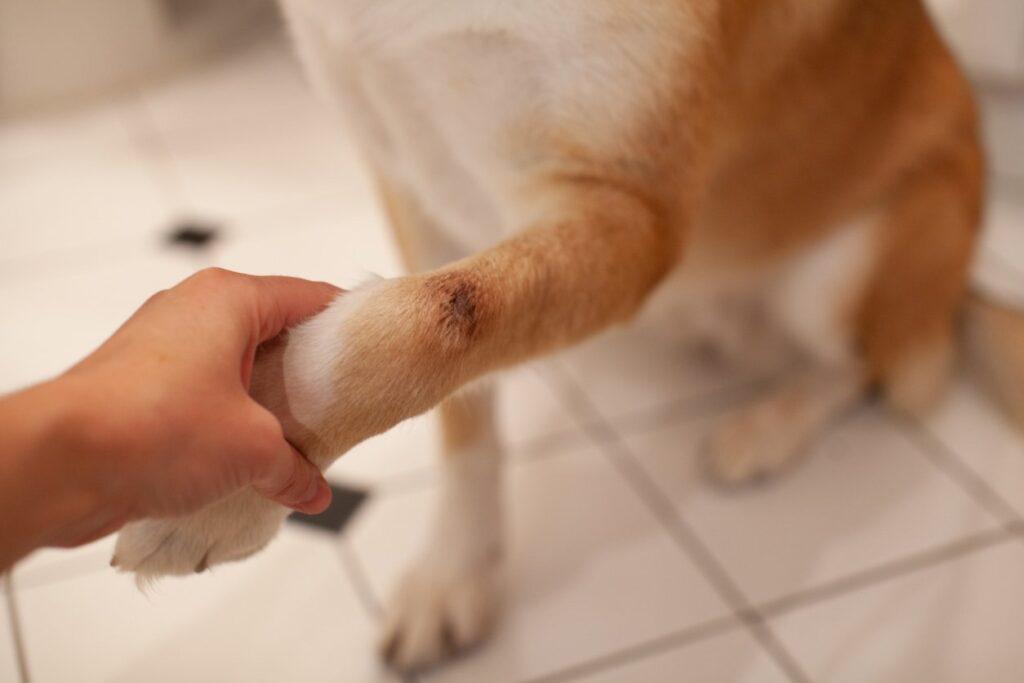
Now, depending on where the issue is happening may give us more information on what to do to help. For instance, your veterinarian will usually begin with the toes and work their way up to the neck/spine. Sometimes we need to give the veterinarian any information needed to be helpful. Such as, did you see your dog’s injury? Did this happen suddenly, acutely?
Was it something that is getting slowly worse day by day? Did your dog jump out of something like the car or back of a truck? Did your dog slip on ice or flooring, causing the front legs to go out to the side? Did your dog get it’s foot caught in something and try to yank it out? Have you had your dog on flea and tick prevention during the tick season? Have you seen any ticks on your dog?
All of these are really good questions to ask yourself and remember to tell your veterinarian, to help with diagnosing your dog. Things like a tick you found a week ago could mean your veterinarian needs to titer test your dog, to make sure he is ok and does not have lymes. Or if you didn’t think about the fact that your dog jumped down from the deck or bed, and now seems to be limping.
It could be that your dog is a large breed, and during growing developed OCD, Osteochondritis, in the shoulder, which will need surgery to fix. Or, perhaps you have an older dog who is showing pain, and could have arthritis showing up in the elbow or shoulder area. These are all good reasons to give your Veterinarian all the information you can, so that they can correctly diagnose.
We do have an elbow brace here at posh dog knee braces, that can help to stabilize any issues in the elbow joint, and relieve pain, if it is found to be an issue in the elbow. Let us know if you have any questions!
If you are interested in purchasing a Posh Dog Knee Brace for your dog limping front leg you can order your brace from our store, if you would like to join our Facebook community click here.
Hey guys, this is Nikki, Lead Veterinary technician with Posh Dog Knee Braces. So, today I would like to talk about Laser Therapy for Dog’s with knee injuries ACL/CCL, or arthritis, and how it can help! First off, what is Laser therapy? Laser therapy is taking a simple beam of light to penetrate deep into the tissues and produce positive tissue changes. First used on hair regrowth, Laser therapy has been a growing success.
There are 2 types of treatment you will hear. Cold laser, which focuses on the surface of the skin, and blood circulation, while hot laser are for deeper tissues. Hot laser should only be done by medical professionals, as it is used for cutting and burning, as well as healing.
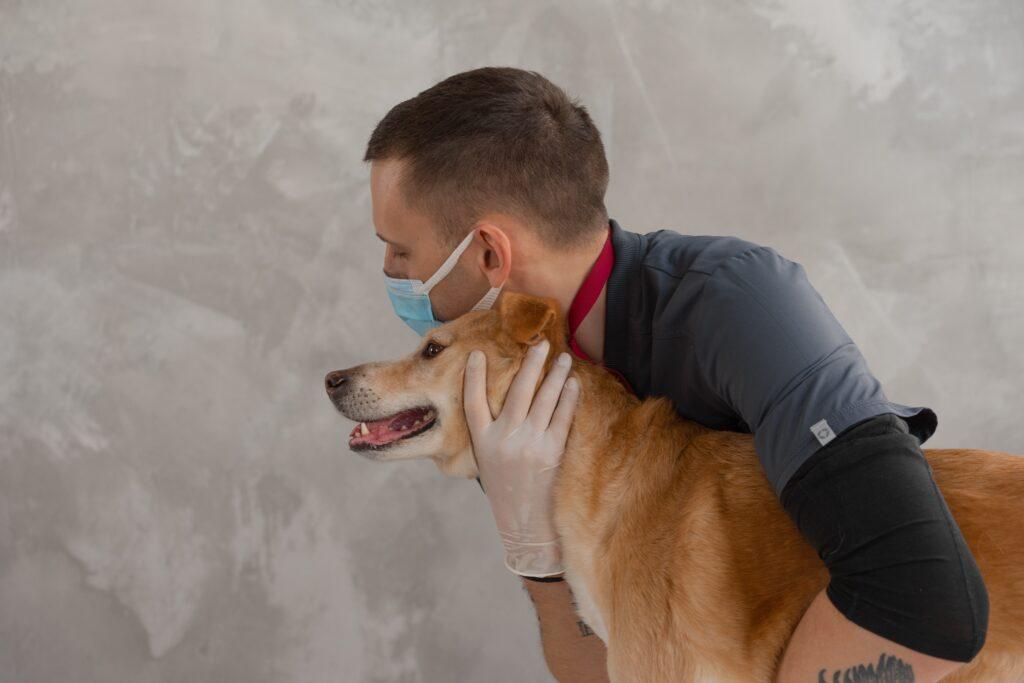
In most practices, we use low-level laser, or class IV laser therapy. Depending on the class of the laser, will tell you if it is something you can do from home or by a clinician. Quality laser equipment is very expensive, thus most will opt for therapy with their holistic vet, chiropractor, or veterinarian.
So, how do dogs react to having laser therapy done? They find it very relaxing. Laser therapy releases endorphins, so dogs usually find it relaxing and positive. Another benefit, is that your dog will not need to be sedated for laser, they can be resting and wide awake. There is no need to clip the hair away either, like other treatments. There is usually no side effects, the type of lasers used should not cause any burns to the skin.
So how will this help a dog with a ccl tear? Cold laser therapy for dogs with cruciate ligament injuries, restore health to damaged tissue cells by stimulating their ability to grow and survive, and heal naturally. It helps relieve pain and limping as well. If used with conjunction with an orthotic (brace) this would give your pup a good chance of fully recovering with less pain.
Please call or email with any questions! Poshintake1@gmail.com, or 509-412-3065. You can also leave us a message on our contact form or visit our Facebook page.
Thanks!
Read reviews check out our Google Reviews online. Click Here
Genetics do factor in sometimes on whether our dogs will have a CCL tear or not. Such as, I don’t see tears as much in sporting breeds like springer spaniels or setters, but do in rotties and newfies. Not saying I have never had a sporting breed like springer or setter come in with an acute injury, but I don’t feel their genetically prone to the issue like other breeds are.

The following breeds have much higher chances of CCL injuries, including bilateral injuries. Mastiffs, Newfoundlands, akitas, St. Bernard’s, rottweilers, Chesapeake bay retrievers, American Staffordshire terrier, and laborador retrievers. Also Golden retrievers seem to also be affected more often that smaller breeds.
Toy breeds tend to have luxating patella issues, where the kneecap moves back and forth, thus causing concurrent CCL tears secondary to the LP issue. We do see a fair share of chihuahuas, maltese, shihtzu’s, and Pomeranians as well.
So what if your dog is on the list? What can we do? Well, there are a few things you can do. First off, don’t spay and neuter before they have reached maturity (~14 months), feed a breed appropriate diet with no bye products. Diet correlates to muscle and ligament growth so much, which is why it is so important to start your puppy out the right way, on a good diet. Preventing your dog from jumping in the air to play fetch, or turn corners too sharply.
Instead, roll the ball on the ground for them to run after. Getting them on a good bone supplement may help, we need to feed those growing ligaments all the goodies we can, and sometimes they need more than their food will provide.
Bones with marrow are great, bone broth is great, shark cartilage is good. There are many things you can give that are good for your pup. Taking your dog on regular leashed walks, and exercising them properly will also help. Especially with our more lazy breeds, you know who you are! 😊
Dogs with more bowing in the knee tend to also get tears more frequently, such as rottweilers and any staffy breeds. Again, try to keep these pups from jumping or rough play, as that can put stress on the joints.
Let us know if you have any questions, poshdogkneebrace.com, or email me on our contact form or visit our Facebook page.
Read reviews check out our Google Reviews online. Click Here
Today I would like to talk about recommended activity levels with a brace or CCL tear. It is still important to remember that this is not a race.
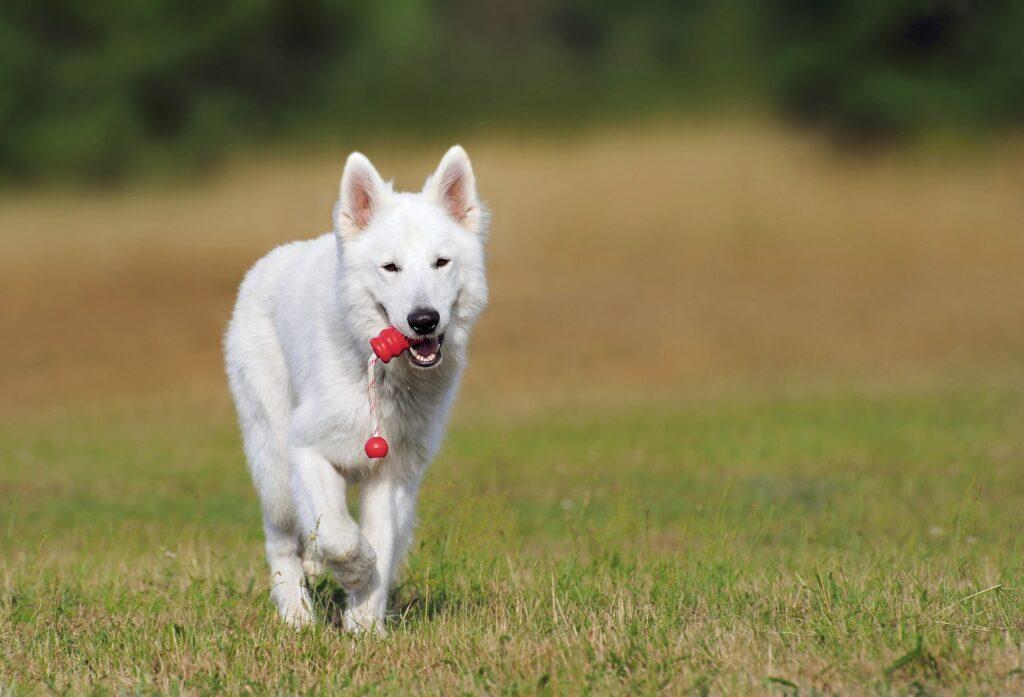
Initially, we start with walks and light physical therapy and massage. Gradually, we can increase activities, such as adding hills or inclines to the walk, sit stands, more muscle building activities.
It is not recommended to let your dog run off leash while in recovery. This can lead to injury of the other leg potentially. Braced walks are meant to be nice and slow, not a jog. The goal is to have your dog placing full weight down on his leg. If you walk or run too fast, they will skip and not place full weight on the leg.
We will get to a point where your pup can play off leash, but ask first, and take things slow. Feel free to email or send in a contact request with any questions about what levels of activity is right for your dog, we are happy to help! You can reach out to use through our contact form or visit us on our Facebook page.
Give Your Dog a Big Hug From Us!
Nikki, Posh Lead Veterinary Technician
Read reviews check out our Google Reviews online. Click Here
Today I want to discuss signs that your dog has a CCL tear, and if he or she needs a brace. First, obviously your poor dog is exhibiting signs of hind limb lameness. Now this can happen two ways. First, you hear a yelp, or see the injury, and have sudden onset lameness. This is about 50% of dogs, and is called an acute injury. Your pup will not use his or her leg, and is toe touching.
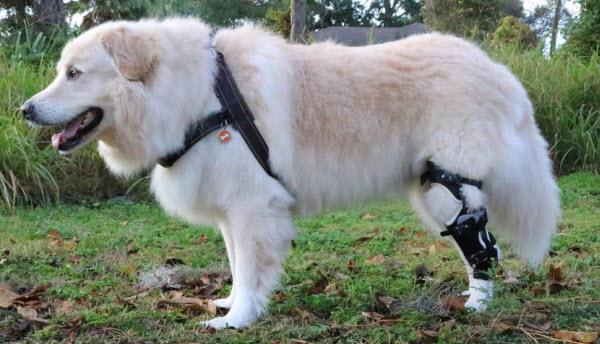
Second, you notice your dog limping on the hind leg after exercise, and after rest seems better. This goes on for a few weeks until you have a veterinarian diagnose the injury as a CCL full or partial tear. Some of these patients go a year or longer before getting to full limping. This is a chronic case, and usually degenerative.
We can help with either situation, as even a partial tear will keep re-injuring over and over until externally supported with a brace.
After a while you may notice a medial buttress, or a hard bump on the inside of the knee. This is a sign of cruciate injury as well.
No matter how long you wait, it is never going to be too late to brace your dog, as bracing will help stop the offloading that is happening, and we can start working on that thigh muscle to reverse the atrophy. Let us know if you have any further questions about this topic, and always feel free to send me a contact request, I am happy to chat with you and answer some of your questions you can reach out to me on our contact form or visit our Facebook Page.
Nikki, Posh Lead Veterinary Technician
Read reviews check out our Google Reviews online. Click Here
We get asked this question a lot, and wanted to see if we can answer some questions on diagnosing a CCL tear. Is it necessary to have a diagnosis before purchasing a brace? Answer: Yes! There are many other things, like sprains, hip joint pain, spinal issues, tumors, and nerve issues like DM that can cause hind lime lameness other than a ruptured CCL.
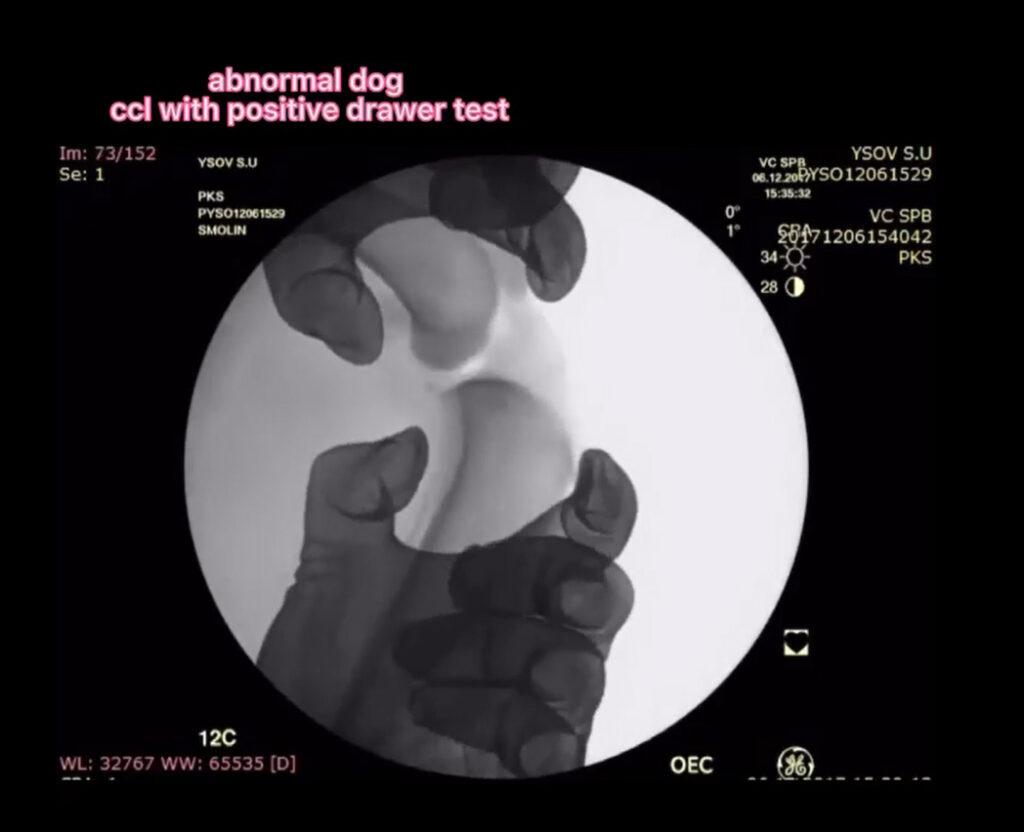
At your appointment with the veterinarian, they will most likely want to do what is called a drawer test. Please note: this could worsen the injury if not done properly, or with sedation, and is very painful. Some patients will let out a yelp, or limp much worse after the examination.
Your veterinarian may also want to do some radiographs during the initial examination. These can show gaps, space, swelling, and rule out tumors in older patients. I do recommend radiographs for any patient over 8 years old.
MRI is the absolute best way to diagnose a CCL tear, however, this can cost upwards of $1,000, and may be hard to find someone to do this.
Find a veterinarian that is gentle, and will do a thorough exam ruling out the other injuries. This is the best method, and least painful for your pup. Also, try taking the last appointment of the afternoon when possible, or the first in the morning, as this is when most veterinarians are less likely to be in a “rush.” Right before lunch break, or in the late morning/afternoon can be rushed due to their surgical load that day, or if they have other patients that have been dropped off to be seen.
We leave the diagnosis up to our clients, it is not required, however, I do recommend at least finding a holistic minded veterinarian to help you! If you need more information on CCL tears you can reach us through our contact form or visit our Facebook Page.
Nikki, Posh Lead Veterinary Technician
Read reviews check out our Google Reviews online. Click Here
Today I would like to go over what a CCL in a dog is, as well as it’s function. First off, a CCL in a dog is the same as saying ACL in a person.
The CCL is a connective tissue in the knee that stabilizes the lower leg to the upper leg. It connects the tibia to the femur. Without this ligament, there can be partial or complete joint instability, pain, and lameness present.
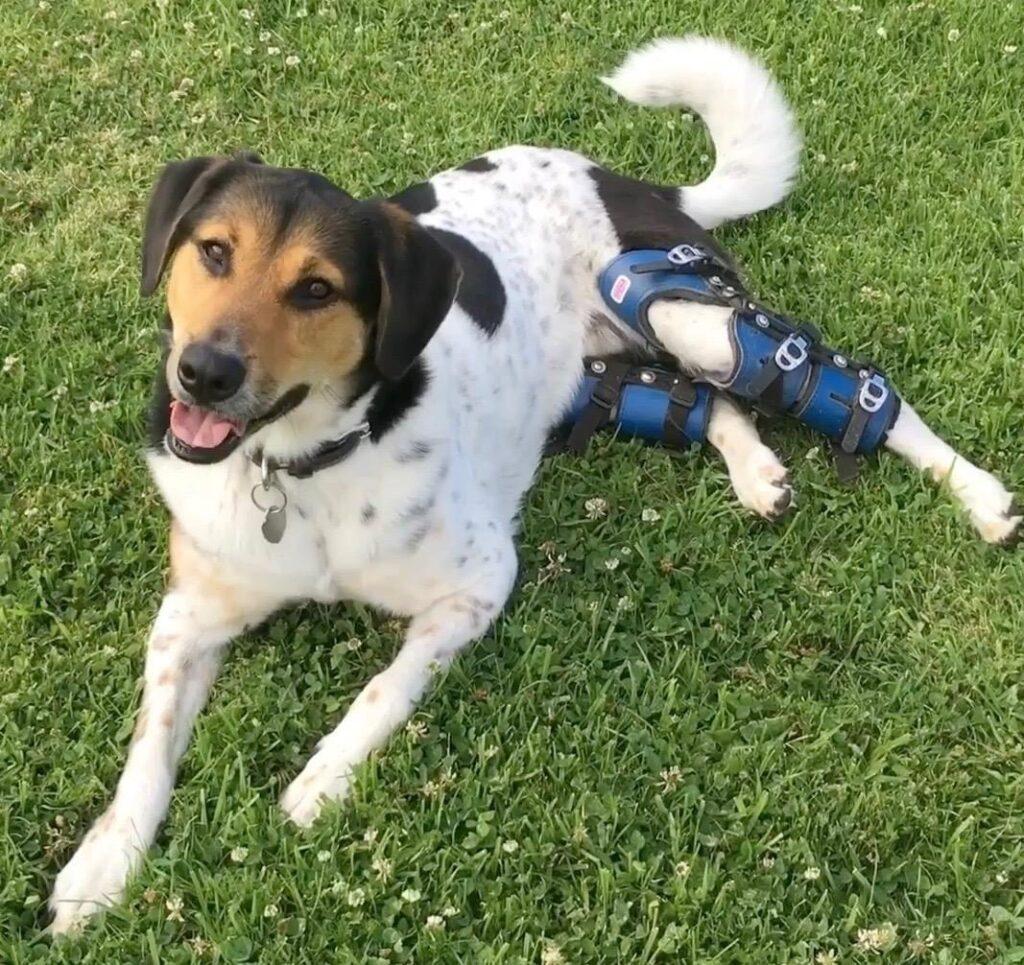
The CCL holds the tibia in place, andprevents internal rotation and hyperextension (which is over stretching the leg). The meniscus (located between the femur and tibia) absorb impact and provide a gliding surface between the femur and tibial plateau/tuberosity. Sometimes the medial meniscus can become torn when the knee is unstable from a CCL tear.
Symptoms of a rupture include crepitus (crackling or popping sound), decreased range of motion, hind leg extended when sitting (when the injured leg is off to one side), pain to the touch, not wanting to move as much, sore after a walk, swelling, and turning the leg out to the side when standing.
Leaving a ruptured ligament alone, without the aid of bracing, can leave misaligned joint causing further damage, inflammation, and pain. This can lead to early joint disease and further meniscus tears.
Bracing helps to hold the tibia in place, while acting as a buffer or shock absorber, preventing further movement and issues from occurring. If you need more information you can contact us through our contact form or visit our Facebook Page.
Read reviews check out our Google Reviews online. Click Here
Many Dog parents are becoming aware how dangerous nsaid drugs are for Dogs. Nsaids have reportedly killed as many as 60,000 Dogs (sixty thousand). Nsaid is the acronym for “Non Steroidal Anti Inflammatory Drug.” It’s completely different then Natural Nutraceuticals.
Just search “rimadyl deaths” — Or read articles like THIS and THIS
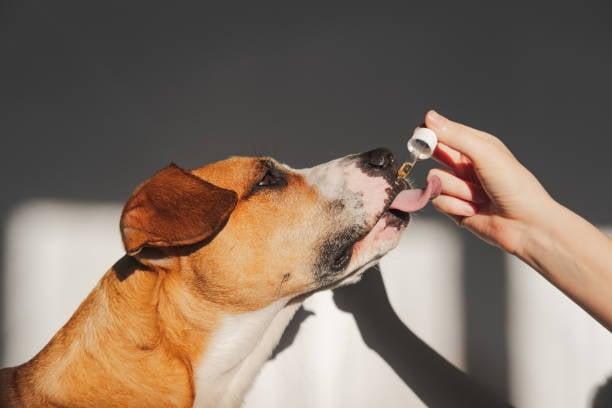
Nutraceuticals are products derived from food sources that are proven to provide extra health benefits, in addition to the basic nutritional value found in foods and are often equally effective at treating and managing pain and inflammation for Dog with injured stifles.
Here is an informative article about this subject:
“Post navigation Nutraceuticals and Inflammation By: Andrew G. Yersin, PhD From IVC Issue: V4I4
Pain management caused by inflammation is an important part of veterinary care. Musculoskeletal pain can result from tissue damage to muscles, tendons, ligaments, bone and articular surfaces. Depending upon location, function and innervation, musculoskeletal pain can have varying characteristics and patterns:
Various types of tissue injury can lead to chronic inflammation and pain through a complex cascade of signaling events. Injured cells release arachidonic acid, a membrane lipid, which is converted through enzymatic reactions to leukotrienes and prostaglandins that can trigger further inflammatory responses and increase the sensitivity of pain receptors. Simultaneously, the release of reactive oxygen species (ROS) and pro-inflammatory cytokines from damaged cells triggers the activation of the transcriptional factor NF-B. This protein serves as a major control point in the inflammatory process, and further perpetuates the cycle of inflammation and pain by increasing the expression of a variety of pro-inflammatory cytokines and enzymes.
Nutraceutical support includes the use of antioxidants, Omega-3 fatty acids, and specific botanical ingredients that target the enzymes and other mediators of the inflammatory signaling cascade, and support a healthy anti-inflammatory response.
Boswellia is powdered gum resin of the plant Boswellia serrata. Active molecules include a variety of triterpenoids, collectively called boswellic acids, that have been demonstrated to be potent inhibitors of the pro-inflammatory enzyme 5-lipoxygenase, and also act via the inhibition of prostaglandin E synthase-1 and the serine protease cathepsin G. In animal and human studies, boswellia has shown to exhibit analgesic and anti-inflammatory effects.
Yucca is dried powder from the plant Yucca schidigera. Active molecules include trans-3,3’,5,5’-tetrahydroxy-4’- methoxystilbene, alexin and reseveratrol, as well as additional saponins and phenolic compounds. These molecules have been demonstrated to act as potent antioxidants and anti-inflammatory agents. One of the primary mechanisms of action for its anti-inflammatory activity is proposed to occur via inhibition of NF-κB and nitric oxide synthase (iNOS).
MSM (methylsulfonylmethane) occurs naturally in fresh fruit, whole grains, vegetables and animals. It serves as a source of sulfur necessary for the health and maintenance of mammalian connective tissues. MSM has been demonstrated to inhibit the activity of NF-κB, leading to a decrease in pro-inflammatory cytokines, nitric oxide, and prostaglandin E2.
Meadowsweet is the common name for the herb Filipendula ulmaria. Key classes of molecules identified in meadowsweet include salicylates, tannins, flavonoids, phenolic acids, and phenolic glycosides. Meadowsweet’s analgesic effects are largely attributed to salicylic aldehyde, a precursor for acetylsalicylic acid (aspirin).
Nutraceuticals may be used to support health and well-being. Whatever treatment strategy you choose, it is important to continue assessing pain and other health indicators to ensure the patient stays comfortable and general health is maintained.”
SOURCE: http://www.ivcjournal.com/articles/nutraceuticals-and-inflammation/
Consider treating the pain and inflammation caused by a dog ACL/CCL knee injury with natural, organic and effective remedies, instead of the dangerous and often lethal nsaids. With a synergistic mix of a Dog knee Brace for ACL injury, increased nutritional supplements for Dog ACL injuries, along with conservative management, your Dog can recover from a CCL rupture, very likely without surgery!
Order your brace today!
Read reviews check out our Google Reviews online. Click Here